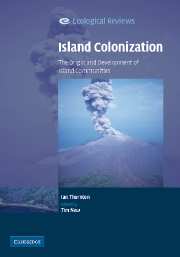Book contents
- Frontmatter
- Contents
- Editorial preface
- Acknowledgements
- PART I Theoretical and experimental studies
- PART II Natural recolonization after devastation
- PART III The recolonization of devastated islands
- PART IV Assembly of biotas on new islands
- 9 Lake Wisdom: a new island of fresh water
- 10 New islands in the sea
- 11 Anak Krakatau, Krakatau's child, b. 1933
- 12 Surtsey, Island of Surtur, b. 1963
- 13 Motmot: an emergent island in fresh water
- PART V Colonization and assembly
- References
- Index
12 - Surtsey, Island of Surtur, b. 1963
Published online by Cambridge University Press: 12 January 2010
- Frontmatter
- Contents
- Editorial preface
- Acknowledgements
- PART I Theoretical and experimental studies
- PART II Natural recolonization after devastation
- PART III The recolonization of devastated islands
- PART IV Assembly of biotas on new islands
- 9 Lake Wisdom: a new island of fresh water
- 10 New islands in the sea
- 11 Anak Krakatau, Krakatau's child, b. 1933
- 12 Surtsey, Island of Surtur, b. 1963
- 13 Motmot: an emergent island in fresh water
- PART V Colonization and assembly
- References
- Index
Summary
Surtur [the Black, the fire-giant] fares from the South
with the scourge of branches,
The sun turns black, earth sinks in the sea.
The hot stars down from Heaven are whirled.
Fierce grows the steam and the life-feeding flame,
till fire leaps high about Heaven itself.
Icelandic poem Voluspa, tenth century, quoted by Sturla Fridriksson in his book Surtsey: Evolution of Life on a Volcanic IslandEmergence and development of Surtsey
The longest physical feature of this planet is almost certainly the mid-ocean ridge, a narrow deep trench running down the middle of the ocean floors. It has been likened to the seam of a gigantic tennis ball. Magma from deep inside the Earth emerges along the ridge, and the rigid tectonic plates on each side of it gradually move away from one another, as new ocean floor is created on each side of the ridge as the cooling magma becomes lava. The ridge becomes subaerial at one place in the North Atlantic, where the island of Iceland has been formed. On Iceland, continuing activity along the ridge creates new real estate, and Iceland is increasing in area.
In early November 1963, earthquakes were registered some 33 km off the southern coast of Iceland. On the morning of 14 November, 20 km from the nearest large island, Heimaey, of the volcanic Westman Islands, fishermen smelled sulphurous fumes as they were casting their lines, and saw a column of vapour rising from the sea surface not far from their boat.
- Type
- Chapter
- Information
- Island ColonizationThe Origin and Development of Island Communities, pp. 157 - 184Publisher: Cambridge University PressPrint publication year: 2007



